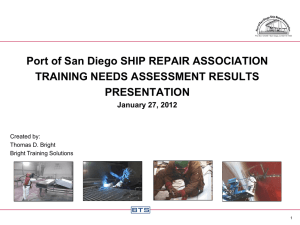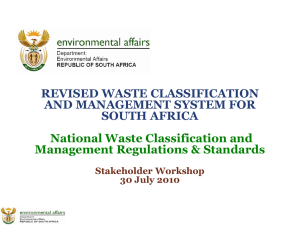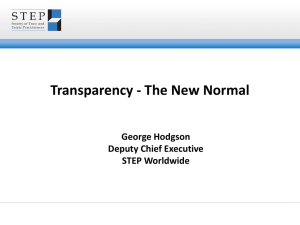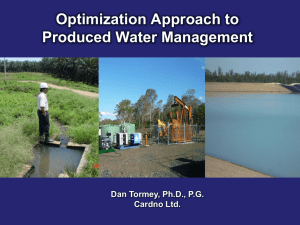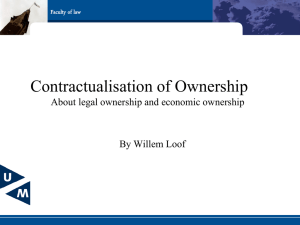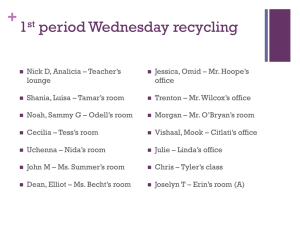Form R1
advertisement
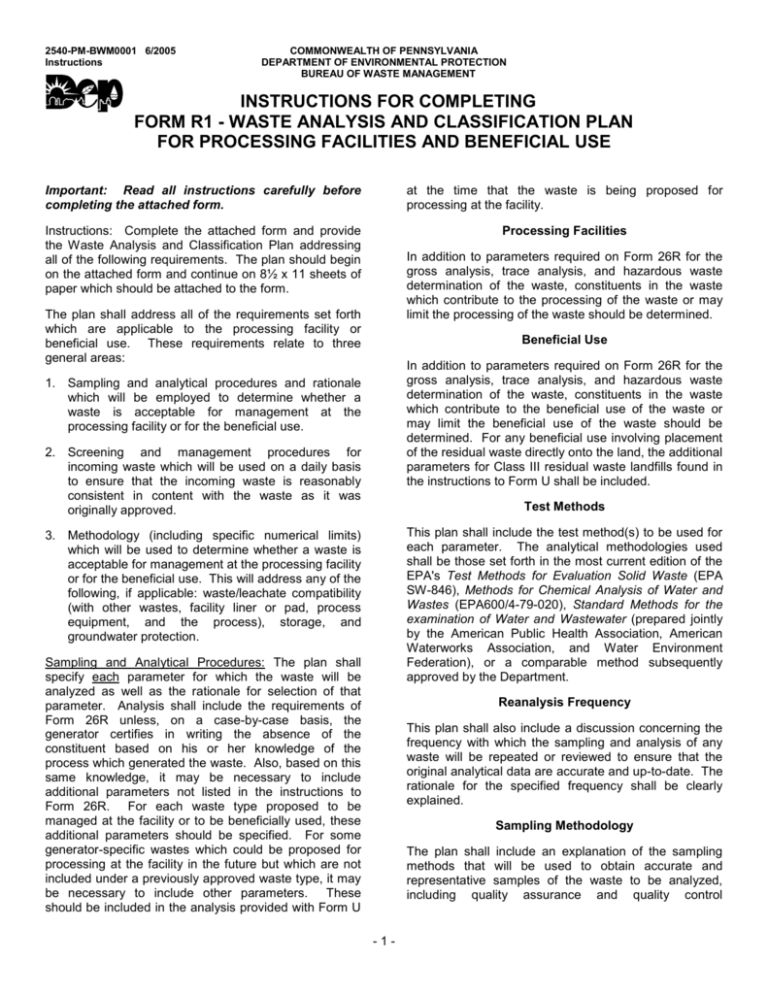
2540-PM-BWM0001 6/2005 Instructions COMMONWEALTH OF PENNSYLVANIA DEPARTMENT OF ENVIRONMENTAL PROTECTION BUREAU OF WASTE MANAGEMENT INSTRUCTIONS FOR COMPLETING FORM R1 - WASTE ANALYSIS AND CLASSIFICATION PLAN FOR PROCESSING FACILITIES AND BENEFICIAL USE Important: Read all instructions carefully before completing the attached form. at the time that the waste is being proposed for processing at the facility. Instructions: Complete the attached form and provide the Waste Analysis and Classification Plan addressing all of the following requirements. The plan should begin on the attached form and continue on 8½ x 11 sheets of paper which should be attached to the form. Processing Facilities In addition to parameters required on Form 26R for the gross analysis, trace analysis, and hazardous waste determination of the waste, constituents in the waste which contribute to the processing of the waste or may limit the processing of the waste should be determined. The plan shall address all of the requirements set forth which are applicable to the processing facility or beneficial use. These requirements relate to three general areas: Beneficial Use In addition to parameters required on Form 26R for the gross analysis, trace analysis, and hazardous waste determination of the waste, constituents in the waste which contribute to the beneficial use of the waste or may limit the beneficial use of the waste should be determined. For any beneficial use involving placement of the residual waste directly onto the land, the additional parameters for Class III residual waste landfills found in the instructions to Form U shall be included. 1. Sampling and analytical procedures and rationale which will be employed to determine whether a waste is acceptable for management at the processing facility or for the beneficial use. 2. Screening and management procedures for incoming waste which will be used on a daily basis to ensure that the incoming waste is reasonably consistent in content with the waste as it was originally approved. Test Methods This plan shall include the test method(s) to be used for each parameter. The analytical methodologies used shall be those set forth in the most current edition of the EPA's Test Methods for Evaluation Solid Waste (EPA SW-846), Methods for Chemical Analysis of Water and Wastes (EPA600/4-79-020), Standard Methods for the examination of Water and Wastewater (prepared jointly by the American Public Health Association, American Waterworks Association, and Water Environment Federation), or a comparable method subsequently approved by the Department. 3. Methodology (including specific numerical limits) which will be used to determine whether a waste is acceptable for management at the processing facility or for the beneficial use. This will address any of the following, if applicable: waste/leachate compatibility (with other wastes, facility liner or pad, process equipment, and the process), storage, and groundwater protection. Sampling and Analytical Procedures: The plan shall specify each parameter for which the waste will be analyzed as well as the rationale for selection of that parameter. Analysis shall include the requirements of Form 26R unless, on a case-by-case basis, the generator certifies in writing the absence of the constituent based on his or her knowledge of the process which generated the waste. Also, based on this same knowledge, it may be necessary to include additional parameters not listed in the instructions to Form 26R. For each waste type proposed to be managed at the facility or to be beneficially used, these additional parameters should be specified. For some generator-specific wastes which could be proposed for processing at the facility in the future but which are not included under a previously approved waste type, it may be necessary to include other parameters. These should be included in the analysis provided with Form U Reanalysis Frequency This plan shall also include a discussion concerning the frequency with which the sampling and analysis of any waste will be repeated or reviewed to ensure that the original analytical data are accurate and up-to-date. The rationale for the specified frequency shall be clearly explained. Sampling Methodology The plan shall include an explanation of the sampling methods that will be used to obtain accurate and representative samples of the waste to be analyzed, including quality assurance and quality control -1- 2540-PM-BWM0001 6/2005 INSTRUCTIONS FOR COMPLETING FORM R1, continued procedures employed in the field. A discussion concerning the manner in which temporal and spatial variability of each waste will be addressed (especially in terms of numbers of samples needed and statistical tests to be employed to define variability) should be included. tanks, and other components of the processing equipment. These limits may be based on actual testing or, in lieu of testing, existing published or documented data on the waste or waste generated from similar processes. Testing protocols and use of existing published or documented data is subject to Department approval. Screening of Incoming Waste: The plan shall include a description of the method or procedure to screen incoming waste daily to ensure that the waste is reasonably consistent in content with the waste as it was originally approved. The procedure shall, at a minimum, be applied to each waste load as it is received at the processing facility or prior to being beneficially used and shall include a check of the waste's color, physical state, and phases. These characteristics shall be compared with those specified on the Form U or Form 26R which was originally approved. Additional screening parameters may include texture, density, particle size (determined visually), or spectroscopic examination of the waste. Since these screening parameters are very subjective, a procedure to determine whether a waste meets or fails should be included. In addition, for a waste which is rejected based on the screening procedure, a description of the manner in which the rejected waste will be managed shall be included in the plan. This description shall include, as applicable, additional sampling and analysis which may be necessary to determine that the waste is the same waste that was originally approved (or meets the limitations for that waste type), names of responsible persons and municipalities, and the method by which an alternative waste management facility will be selected (if the waste is rejected). Concentration limits in the waste which can be adequately processed in the processing system in a manner that will protect public health, safety, and the environment. These limits may be based on actual testing or, in lieu of testing, existing published or documented data on the waste or waste generated from similar processes. Testing protocols and use of existing published or documented data is subject to Department approval. For those contaminants for which the hazardous waste Toxicity Characteristic applies, the concentration limit shall be less than the Maximum Concentration of Contaminants for the Toxicity Characteristics (as listed in Table 1 of 40 CFR Part 261). For pH, ignitability, and reactivity, the hazardous waste limits in 40 CFR Part 261, as incorporated by reference at 25 Pa. Code 261a.1, shall be set forth. In order to determine whether a waste and/or its leachate is compatible with any other waste or leachate already existing at the facility, either a laboratory compatibility test protocol or a description of how such compatibility will be ensured shall be set forth. The procedure set forth in EPA's "A Method for Determining the Compatibility of Hazardous Wastes" (EPA-600/2-80076) or other equivalent method approved by the Department may be used, Waste Acceptance Procedure: The purpose of this procedure is to quickly and easily determine the acceptability of a waste at a processing facility or for the beneficial use by allowing a detailed comparison of the waste characteristics (which may be submitted with Form U for specific waste streams) with maximum allowable levels (which are based on process limitations, waste and liner compatibility, protection of groundwater, and protection of human health and the environment from harm or threat of harm). Beneficial Use For each parameter or contaminant which may be applicable to or exist in any waste (or its leachate) which may be beneficially used, the following limits shall be set forth: Concentration limits in the waste/leachate which will adequately ensure the integrity of the liner, pad, tanks, and other components or any storage equipment. These limits may be based on actual testing or, in lieu of testing, existing published or documented data on the waste or waste generated from similar processes. Testing protocols and use of existing published or documented data is subject to Department approval. Concentration limits in the waste which can be beneficially used in a manner that will protect public health, safety, and the environment. These limits may be based on actual testing or, in lieu of testing The following discussion sets forth the information which shall be included in the waste acceptance procedure. Processing Facilities For each parameter or contaminant which may be applicable to or exist in any waste (or its leachate) which may be processed at the facility, the following limits shall be set forth: Concentration limits in the waste/leachate which will adequately ensure the integrity of the liner, pad, -2- 2540-PM-BWM0001 6/2005 INSTRUCTIONS FOR COMPLETING FORM R1, continued existing published or documented data on the waste or waste generated from similar processes. Testing protocols and use of existing published or documented data is subject to Department approval. For beneficial use where the waste is proposed to be used as a construction materia1, soil substitute, soil additive, antiskid material, or otherwise placed directly onto the land, the concentration limits shall not exceed the requirements of 25 Pa. Code 288.623(a) (relating to minimum requirements for acceptable waste). For pH, ignitability, and reactivity, the hazardous waste limits in 40 CFR Part 261, as incorporated by reference at 25 Pa. Code 261a.1, shall be set forth. Transfer Facilities: The plan for transfer facilities shall include all applicable requirements for other processing facilities. In addition, the plan shall include a procedure to ensure that the facility destined to accept any waste shipped from the transfer facility has the approval of the appropriate regulatory agency to manage the waste. If different waste types are consolidated at the transfer facility, the plan shall address a procedure to ensure each waste type has the necessary approval for management at the destination facility. For those contaminants for which the hazardous waste Toxicity Characteristic applies, the concentration limit shall be less than the Maximum Concentration of contaminants for the Toxicity Characteristics (as listed in Table 1 of 40 CFR Part 261). -3- Date Prepared/Revised 2540-PM-BWM0001 6/2005 COMMONWEALTH OF PENNSYLVANIA DEPARTMENT OF ENVIRONMENTAL PROTECTION BUREAU OF WASTE MANAGEMENT DEP USE ONLY Date Received FORM R1 WASTE ANALYSIS AND CLASSIFICATION PLAN FOR PROCESSING FACILITIES AND BENEFICIAL USE This form must be fully and accurately completed. All required information must be typed or legibly printed in the spaces provided. If additional space is necessary, identify each attached sheet as Form R1, reference the item number and identify the date prepared. The “date prepared/revised” on any attached sheets needs to match the “date prepared/revised” on this page. SECTION A. SITE IDENTIFIER Applicant/permittee: Site Name: Facility ID (as issued by DEP): -1-
